By Belunn Se, senior industry observer based in Shenzhen, Guangdong province, China
US President Donald J. Trump, the leader of the world's largest economy, and Chinese President Xi Jinping, the head of the world's most populous nation, met face-to-face ealier this month at Trump's Mar-A-Lago resort in Florida, whichwas a great success setting the tone for the future of Sino-American collaborations.
Trading and industry cooperation play crucial role
According to a briefing of the meeting, the detailed economy-trading cooperation between China and America landed onto the 100-day plan to narrow the America trade deficit and increasing exports to China.
Looking back from the campaign trail, Trump called for fewer regulations and taxes cuts and to re-negotiate trade deals to bring industrial jobs back to the US.
He singled out Apple, "We're going to get Apple to build their damn computers and things in this country instead of in other countries," he said during a rally in Lynchburg, Va.
In the early weeks of the new White House administration, Trump met industry executives, saying, "Everything's going to be based on bringing our jobs back—the good jobs, the real jobs. They've left and they’re coming back. They have to come back."
Thus raising an interesting question: from when and who "stole" US jobs?
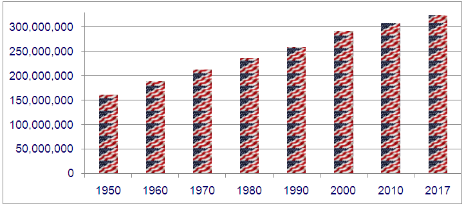
Historic Population of the United States
The US population has grown steadily and more than doubled from 161 million in 1950 to over 300 million (324,485,597 as of 2017).
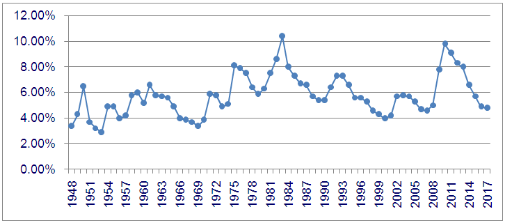
Historic Unemployment Rate of the United States
On the other hand, US has experienced 11 recessions with jobless fluctuations since the end of the postwar period in 1948. But at present, the US' unemployment rate is at its lowest point of 4.5% since 2010, as of March 2017.
Now let's look deeper at the statements: "Buy America" and "Made in America," by analyzing some data and facts.
Mutual Infiltration and Blending in Sino-US Trade
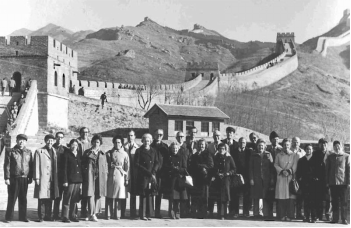
The National Council for US-China Trade's first visit to China in November 1973.
When Sino-US diplomatic relations restarted in 1972, bilateral trade was less than US$100 million. Switching from 1985, the year that bilateral trade was balanced with US$390 million imports and exports respectively; US trade meets a continuous deficit with China.
China, as America's largest import partner, contributed US$347.04 billion of the total US$735.46 billion deficit in 2016 when America global trading reached to US$3,642.9 billion high, Sino-US bilateral trade grew to US$578.59 billion.
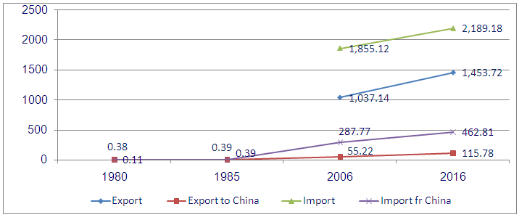
US Trade with China (Unit: US$ billion)
The purpose of trade is to exchange goods and commodities you want to buy, and to organize production modes effectively where advantages are optimized by job allocations, which can be aligned with the WTO's free trade spirit.
US consumers benefit more from trade with China. The "Made in China" goods, bought by Americans, were made by the Chinese, via labor-intensive, resources intensive, relatively low value-added middle-low end commodity productions.
Social and Enterprises Productivity Competence Power
China is the world 2nd largest GDP (gross domestic product) country, but per capita GDP remains low; internal market potential is huge, but still to be further explored.
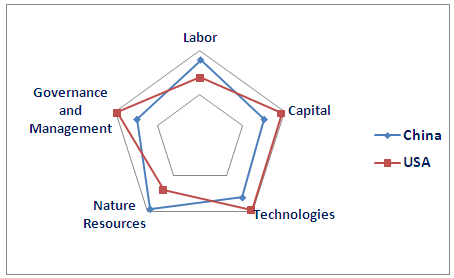
Social Enterprises Productivity Competence Power Contrast
Moreover, compared with their counterparts in America in the above 5 Social and Enterprises Productivity Competence Power, advantages for Chinese enterprises so far can only be found in these two items: Nature Resources and Labor.
Even in the labor sector, China is facing rising production costs, low-level skills, and a shrinking workforce have become more formidable challenges when China's "Median Age" has risen up to 37.1, which means with 50% of its population age is older than 37.1, likewise it's 37.9 in the US.
Globalization of Job Allocation and Profit Argument Power
"Made in America" brands have also been satisfying global consumers as well. The Starbucks chain store accounts for 40% of global cafes; Coca Cola can be found in nearly every department store on the planet; Holly Wood movies and TV have generated US$14.3 billion in exports worldwide last year.
In consumer electronics segment, in Apple's first quarter of fiscal 2017, revenue with China contributed to 20.7% of its US$78.351 billion global revenue at US$16.233 billion.
Furthermore, global smart phone profit in 2016 was up to US$53.7 billion; while Apple, the typical "Made in China" America Brand, grasped 79.2% of all the industry's profits alone.
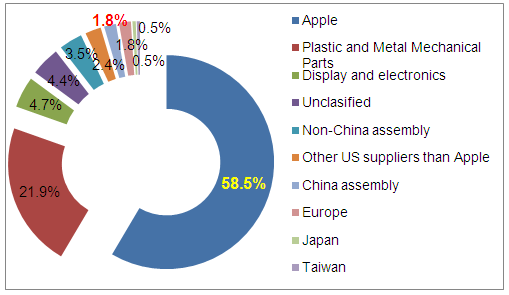
iPhone global supply chain profit allocation illustration
Moreover, in iPhone's internal supplier chain, even hundred thousands of workers in China assemble for the gadget, this part only captures 1.8% of its global profit.
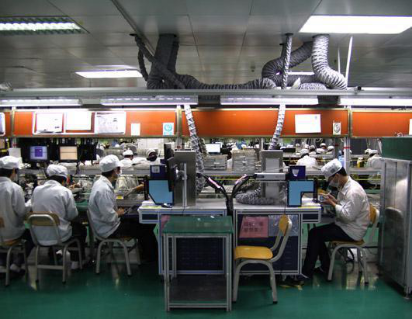
iPhone assembly Line (Archive Photo from Internet)
Just not sure that such a boring manual assembly operator job, which is losing its attraction to younger Chinese generations, should be deemed a "good job" for American workers.
Another example is Wall Street, which is well known for its financing services. According to statistics, 34 financial services companies' market capitalization amounted to US$1,624.5 billion as of Dec.31, 2010, an equivalent to 11% of US GDP in 2010.
But Elites in Wall Street and Silicon Valley may have no opportunity to experience or visit the Chinese production line or workers' dormitory.
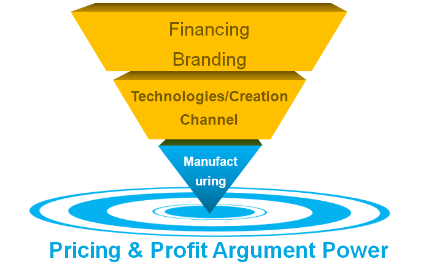
As a wave a Chinese leading companies such as Haier, Huawei delivering quality and innovative products with Artisan Spirit to the worldwide market, "Made in China" reputation is on its way from "manufacturing" to "branding" that would attract more consumers!
Localization for Branding Positioning close to Market and Consumer Minds
A professor in the University of South Carolina, asked his students, after depicting the characteristics of Japanese goods including Sony, Toyota, etc., which country provides these products. The answer students gave was "China," not Japan.
After the imported brands' acceptance process, local production has transformed US consumer impressions -"Toyota, Made in America; GM, Made in Mexico."
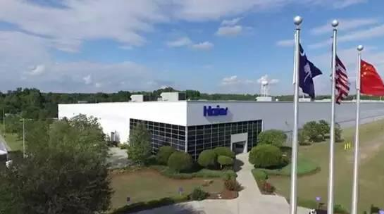
Haier American Plant
Chinese brands also "Made in America", China home appliance developer, Haier has built an industry park in South Carolina in early 1999. As the first wave of Chinese companies opening a major manufacturing facility in the US, Haier not only considers the large volume refrigerator logistic and production costs, but addresses branding considerations for the local market as well.
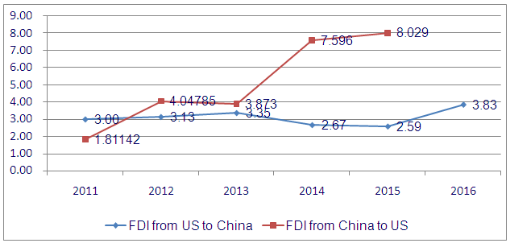
FDI between China and the U.S. (Unit: $ billion)
Meanwhile, FDI (foreign direct investment) from China to US has been increasing in the past 13 years, which in 2015 reached US$8 billion, a record high.
If the US would like to create more manufacturing jobs, tariff increases would not help, but could trigger turmoil across the country's borders, let alone whether it complies with WTO regulations and US congress approval.
Dynamic win-win Sino-US Tight Collaborations towards Future
Consumers benefit from a wide range of products to choose from. Free global trading enhances these possibilities.
China and America, as the world's 2nd and largest economy entities respectively, can stay focused on rational mutual understanding and win-win cooperation to enjoy bright, dynamic, and tight collaboration for the future!

Belunn Se, senior industry observer based in Shenzhen, Guangdong province, China.
(The opinions expressed here do not necessarily reflect the opinions of Panview or CCTV.com)

Panview offers a new window of understanding the world as well as China through the views, opinions, and analysis of experts. We also welcome outside submissions, so feel free to send in your own editorials to "globalopinion@vip.cntv.cn" for consideration.















